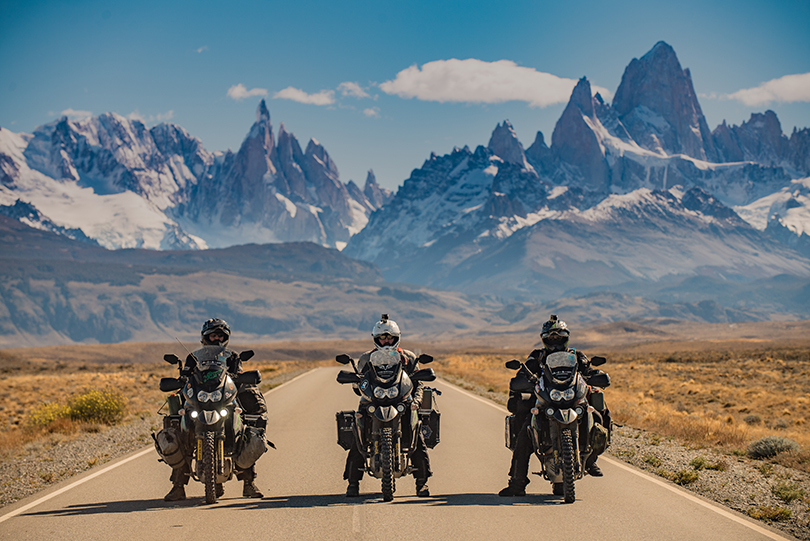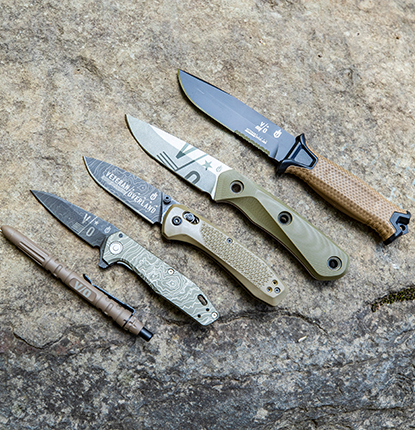
On April 1, 2018, three army vets on exhausted Kawasaki KLRs—and one incredibly grimy support van—rolled into Ushuaia Argentina, marking the end of the 18,571-mile journey from Dead Horse Alaska over 178 days. (The group started with four bikes, but we’ll get to that.)
With the trip complete, we asked team rider Wayne Mitchell and videographer Jake Hamby to share some experiences from the first-ever motorcycle traverse of the Pan-American Highway.
Not surprisingly, the team accounted for every conceivable challenge along the way, yet still faced situations they weren’t prepared for. Through blistering cold, monsoon rains, and mechanical failure due to extreme conditions, they found ways to continue on, using only the tools and resources they had with them.
Jake Hamby: “Snow got into the electrical system of one of the bikes and we were unable to fix it. We ended up strapping a Gerber spotlight to the sidecar to provide a little emergency light to the rider.”
Wayne Mitchell: “Not even joking when I say I used my Gerber Center-Drive every day to tighten bolts, open meals, tighten wires that held on my kickstand. I even had my motorcycle pants modified with belt loops so I could keep it on me.”
Riding through Alaska and Canada in November and December, temperatures often plummeted to 20º below at night. Studded tires became rock-hard and lost traction, engines refused to turn over, and heated riding gear failed.
WM: “Motorcycles and people do not operate well in those conditions. We wore several layers of clothing, at one point I cut up a sleeping pad and stuck it into my pants because my knees and shins were cold.”
JH: “Canada was actually colder than the Dalton Highway and we were camping most nights because of the distance between cities. Most mornings we used a portable heater to warm up each engine to get them to start.”
The US and Mexico provided a welcomed intermission from the elements, other than some occasional rain and high winds, but trading the freezing cold and snow of the Arctic for the monsoons of Central and South America was no improvement. A wetter-than-normal dry season in Panama left the team battling thick, unforgiving mud.
WM: “Everything was coated in mud after the first day. The tires picked up heavy amounts of debris (mud, sticks, leaves, and one tuna can). It would block up the fender well and lock up the back tire. Sometimes we would have to stop every 300 meters and clear out the wheel and cut vines and grass away from the chain and axles.”
JH: “Trying to ride through a giant mud pit in the jungle destroyed the clutches on the motorcycles. We used mechanical winches, pulleys, and good old-fashioned raw manpower to get through. At one point we created a zipline over a particularly rough section and sent the bikes across that way. We ended up abandoning one and just pushing the other three out.”
When the team finally emerged from the jungle, they were filthy, exhausted, and pushing three crippled bikes. They agreed to head into the nearest town for some much-needed rest and repairs before finishing the last leg of the journey. But the adventure was far from over.
JH: “We popped out of the jungle onto the Atrato River and had to take a boat to Turbo, Colombia. The only boat available was extremely tiny, but the crew insisted we could put all three bikes, the nine of us, and the three of them on the boat. We crossed five miles of open ocean in the middle of the night and the boat had no lights. We were all hyper-aware of the fact that if the boat went down, that would be the end of it.”
WM: “Even though we made it through the Darién in 8 days, we ended up spending nearly 15 more days in Columbia waiting for parts and repairing the bikes from the damage we did dragging them through the jungle. We had to make up lost time and most of us had to be back to work in the United States. We ended up doing a couple 500-mile days and rode at night on long stretches of desert or grasslands where the roads were straight and flat.”
Finally, the team completed their journey. Tired, dirty, and thankful to be crossing the finish line, they dropped their kickstands down in Ushuaia Argentina. Although there is already talk of the next big adventure, for now the crew is enjoying the return to everyday life and focusing on producing a documentary film of the trip.
JH: “Really, no one else has ever ridden from AK to Argentina through the Darién Gap in a continuous trip, and we captured it all. We’re really excited to finish the film and show some stuff that hasn’t been seen before.”
The team is aiming for a late-2019 release.





